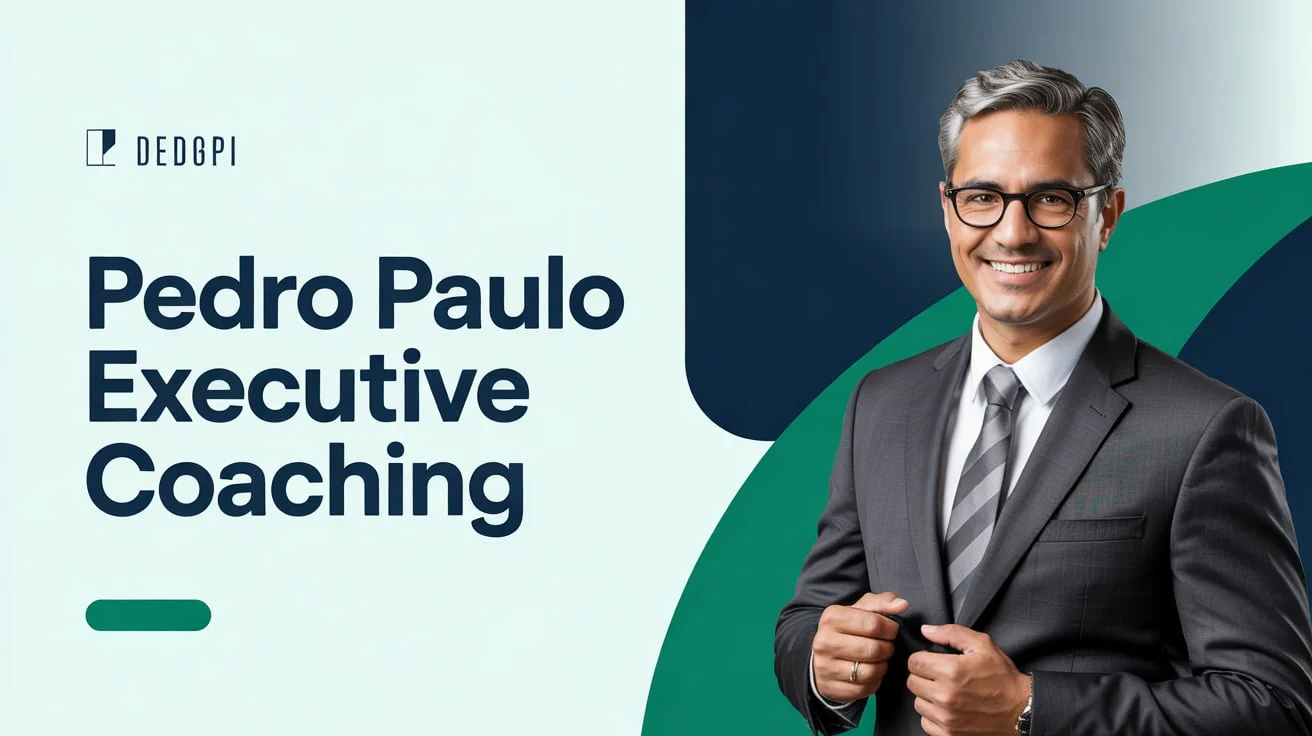In today’s fast-paced business world, leaders can’t afford to stay stuck. They need clarity, emotional grip, and a strategy that’s rooted in reality. Pedro Paulo Executive Coaching offers that. This post dives deep into how Pedro’s coaching transforms leaders, backed by real methods, case studies, and actionable frameworks.
Imagine a leader who’s stressed, unclear, and pulled in ten directions. Six months later, she’s confident, decisive, and inspires her team. That’s not magic — that’s transformation through structured coaching.
Executive coaching is no longer a luxury—it’s a necessity. With shifts in markets, work models, and stakeholder expectations, leaders must evolve continuously. Yet many feel stuck or isolated at the top.
This article will:
- Explain Pedro Paulo’s coaching philosophy and methods
- Show real-world results (with numbers and case studies)
- Lay out how his coaching process works, step by step
- Help you decide whether this coaching is right for you
Let’s dig in.
Background: Who Is Pedro Paulo?
Pedro Paulo (also referred to as Pedro Vaz Paulo in some sources) is a recognized executive coach specializing in leadership development, emotional intelligence, and strategic transformation.
Key Credentials & Experience
- Over 15 years in coaching, consulting, and leadership development roles.
- Background combining business strategy and psychological insight.
- Works with a broad clientele: CEOs, senior executives, emerging leaders, startups, and teams.
Coaching Philosophy & Style
Pedro believes every leader is unique, so cookie-cutter solutions don’t cut it. His coaching merges behavioral science with practical leadership tools.
He stresses:
- Authenticity and values alignment
- Measurable progress and accountability
- Deep introspection balanced with action
- Flexibility — adapting methods to client context
Because of that, his clients often say they don’t just learn — they become a different, improved version of themselves.
The Leadership Challenges Organizations Face
Even high-performing organizations struggle with gaps at the leadership level. Coaching doesn’t fix every problem, but it can address it in a targeted way.
Common Leadership & Organizational Issues
| Problem | How It Shows Up | Impact |
| Lack of clarity & vision | Teams unsure what to focus on | Wasted effort, misalignment |
| Communication breakdown | Messages distorted across levels | Friction, confusion, low trust |
| Indecision or delay | Leadership freezes under pressure | Missed opportunities |
| Delegation failure | Leaders hold too much | Bottleneck, burnout |
| Weak culture & low morale | Teams feel disconnected | High turnover, low engagement |
| Scaling pain | What worked in small team fails at scale | Chaos, structural breakdowns |
Traditional leadership training often emphasizes lectures or frameworks. But it falls short on personalization, feedback loops, and the sustained habit change required to make leadership growth stick.
Pedro’s coaching aims exactly at those weak points.
Proven Strategies Pedro Paulo Uses
Below are core strategies and tools Pedro uses to transform leaders. Each has depth — he doesn’t just scratch the surface.
Strategic Visioning & Goal Setting
- Vision workshops: Facilitated sessions where leaders articulate their north star—where they want the organization or team to go.
- OKRs / goal frameworks: He helps craft Objectives & Key Results to tie vision to measurable steps.
- Road mapping: Breaking multi-year goals into quarterly or monthly milestones.
Case example: One executive client lost direction after a merger. Pedro led two half-day vision retreats, redefined the strategic pillars, set OKRs across functions, and within 6 months saw 40 % better alignment in cross-department execution.
Emotional Intelligence & Self-Awareness
- 360° feedback and psychometric assessments provide data on blind spots.
- Reflection exercises encourage leaders to journal or debrief critical moments.
- Emotional regulation tools: pause-and-breathe, naming emotions before reacting.
One client discovered through feedback that his “directness” was undermining trust. Over months, he modified his style, and employee surveys showed a 25 % increase in perceived approachability.
Communication & Influence
- Storytelling & narrative crafting: Turning data and strategy into stories people resonate with.
- Stakeholder mapping: Identifying interests, influence, resistance across people.
- Active listening & feedback loops: Ensuring messages land as intended.
Example: a CFO used these techniques to break down silos between finance and operations. His narrative shift made both sides “win” rather than fight.
Decision-Making & Accountability
- Decision frameworks (RACI, DACI, cost-benefit models) to clarify who owns what.
- Delegation models: how to hand off work while retaining accountability.
- Regular check-ins & progress reviews: holding leaders to deadlines and adapt when things change.
One CEO reduced decision bottlenecks by 50 % after defining clear decision rights with Pedro’s help.
Culture Building & Team Dynamics
- Culture audits: interviews, surveys, observation of the “real culture.”
- Values alignment workshops: ensuring team behaviors and norms match stated values.
- Peer coaching and cross-functional dialogues: breaking down silos and building shared understanding.
In one case, a mid-level unit’s turnover dropped from 18 % to 8 % after a culture reset driven by coaching.
Real-World Results & Case Studies
Seeing numbers and stories makes the transformation tangible.
Case Study: Mid-Sized Tech Company
Challenge
The CTO was promoted to CEO but struggled with vision-setting and cascading goals across R&D, product, operations. Teams were misaligned, and deadlines kept slipping.
Intervention
- Pedro initiated a 90-day diagnosis: interviewing leadership, gathering feedback, mapping gaps.
- Held vision-setting retreat with leadership team.
- Established OKRs for each department.
- Monthly check-in coaching sessions.
- Mid-term “pulse surveys” to staff to measure progress.
Results (12 months later)
- On-time project delivery improved by 35 %
- Employee engagement scores +22 %
- Strategic alignment in 3 key business units
- CEO’s rating on executive team trust jumped from 3.2 to 4.5 (on 5-point scale)
Case Study: Scaling a Start-Up
Challenge
A founder had taken a startup from 5 to 50 people. Growth stalled. The founder’s instinctive style didn’t scale. Teams complained of micromanagement and lack of clarity.
Intervention
- Assessment revealed founder’s default was “do-it-yourself.”
- Coaching focused on delegation, mindset shift, building team capacity.
- Pedro introduced structures: leadership huddles, decision matrices, role clarity.
- Coached founder to let go gradually, with metrics.
Results
- The founder scaled back hands-on involvement by 60 %.
- Four internal leaders emerged and took responsibility.
- Growth resumed: 3x revenue in 9 months.
- Burnout indicators dropped significantly.
Testimonial Quotes
“Working with Pedro changed the way I lead, not just what I do. His guidance sharpened my clarity and freed me to let others lead.”
— Senior executive, SaaS company
“He holds you gently but firmly accountable—exactly what I needed.”
— Founder & CEO, growth-stage startup
How Pedro Paulo’s Coaching Process Works
This is the “how” behind transformation. Knowing it helps you see the commitment and structure.
Initial Assessment & Diagnostic Phase
- Deep intake interview
- Stakeholder interviews (peers, direct reports, bosses)
- Feedback tools: 360°, psychometrics, surveys
- Organizational context scan (culture, gaps, pressures)
This phase uncovers root issues rather than superficial symptoms
Tailored Plan Design
With diagnostic findings, Pedro designs a roadmap of goals, behaviors, timelines, and milestones. It’s not rigid. He builds in adaptation.
Coaching Sessions & Interventions
- One-on-one sessions: deep dives into challenges, action planning, accountability
- Workshops / group learning: leadership cohorts, team alignment workshops
- Live observation: sometimes joins meetings to observe communication dynamics
- Homework & action experiments: real behavior change, not just theoretical talk
Frequency and duration vary by tier: basic programs may have monthly sessions; advanced ones may meet weekly or biweekly.
Progress Tracking & Feedback Loops
- Monthly or quarterly 360° pulse checks
- Milestone reviews
- Adjustments to plans based on results
- Real-time data: e.g., team metrics, stakeholder feedback, business KPIs
Sustaining Change
- Follow-up check-ins after official engagement ends
- Embedding coaching in the culture (peer coaching, leadership rituals)
- Developing internal coaching “champions” to continue momentum
Who Benefits Most — And When Coaching Might Not Be the Right Path
It’s not for everyone. Coaching works best when certain conditions exist—and fails fast when they don’t.
Ideal Profiles
You will benefit if you:
- Are a leader in transition (promotion, new role)
- Feel stuck in your current impact or growth plateau
- Lead teams and need better alignment
- Want to balance personal growth and professional influence
- Are ready to face feedback and change habits
Situations Where Coaching Struggles
- If the organization has deep structural dysfunctions (e.g., broken incentives, toxic culture) that need systemic change
- When stakeholders resist leadership changes
- If the individual is unwilling to self-reflect or change
- When time, attention, or resources are grossly constrained
If these obstacles are present, coaching might help but won’t be miracle medicine.
How to Get Started with Pedro Paulo Executive Coaching
If you’re ready, here’s how to begin.
First Consultation & Discovery Call
You reach out via his website or email. He’ll schedule a call to map out your context, challenges, and goals.
What To Prepare
- Your leadership pain points (e.g., communication, delegation)
- Feedback you’ve received (formal or informal)
- Organizational goals and constraints
- Your aspirations — where do you want to grow?
Investment & Timeframe
- Programs typically 6 months to 1 year, though shorter or extended engagements are possible.
- Fees depend on level, customization, and region. They are premium — this is high-engagement coaching.
- Expect consistent time commitment (sessions, homework, reflection).
Setting Expectations
- You won’t see transformation overnight.
- Real change requires repetition, feedback, iteration.
- Your growth is co-created; your effort matters.
Comparisons & Differentiators
What sets Pedro Paulo Executive Coaching apart? And how does it stack vs others?
Key Differentiators
- Highly customized approach — no templates
- Integration of psychology + business strategy
- Measurement & accountability built in
- Long-term mindset, not quick fixes
- Cultural adaptability — works across sectors & geographies
Comparison Table
| Aspect | Typical Executive Coaching | Pedro Paulo Executive Coaching |
| Approach | Generic frameworks | Customized to leader & context |
| Feedback | Infrequent, anecdotal | 360°, pulse surveys, metrics |
| Accountability | Light | Ongoing, structured |
| Duration | Fixed block | Flexible, adaptive |
| Depth | Surface behavior change | Identity & mindset + behavior |
| Reach | Often local or niche | International, cross-industry |
Choosing a coach is not about picking the flashiest name — it’s about fit, methods, and real deliverables. Pedro’s track record and approach make him strong for those who want deep transformation.
Frequently Asked Questions (FAQs)
How long before I see impact?
Many clients observe shifts in clarity, communication, or composure within 60–90 days. Real, full transformation often takes 6–12 months.
Is coaching hybrid, in-person, or virtual?
All formats are possible. Pedro offers virtual, in-person, or hybrid coaching.
Will coaching address my team and culture—not just me?
Yes. Pedro offers team coaching, culture workshops, and alignment sessions alongside individual work.
What if my organization resists change?
Part of coaching is stakeholder management. But if resistance is systemic and entrenched, coaching alone may not suffice.
Is executive coaching only for senior leaders?
No. While many clients are at senior levels, mid-level leaders, high potentials, and entrepreneurs also benefit.
How do I measure ROI?
Use a combination of internal metrics (team performance, employee engagement, retention) and leadership feedback changes from 360° tools.
Conclusion
Leadership isn’t a static skill—it’s a living practice, shaped by feedback, adaptation, and continuous growth. Pedro Paulo Executive Coaching doesn’t promise overnight miracles. But it offers something far better: a rigorous, personalized path for leaders ready to evolve.
Investing in coaching with Pedro means investing in clarity, emotional strength, culture, and performance that last beyond the contract. It’s not just leadership transformation—it’s legacy building.
If you’re serious about elevating your leadership, reach out for a discovery session today and begin your journey.

Founder of PunnyPeeks and master of celebration magic, David Mass is the creative spark behind the brand’s bold, balloon-filled brilliance. With an eye for color, a flair for design, and a passion for making people smile, David transforms events into unforgettable experiences. From quirky puns to perfectly curated party decor, he believes that every occasion deserves a splash of fun and a whole lot of heart.




